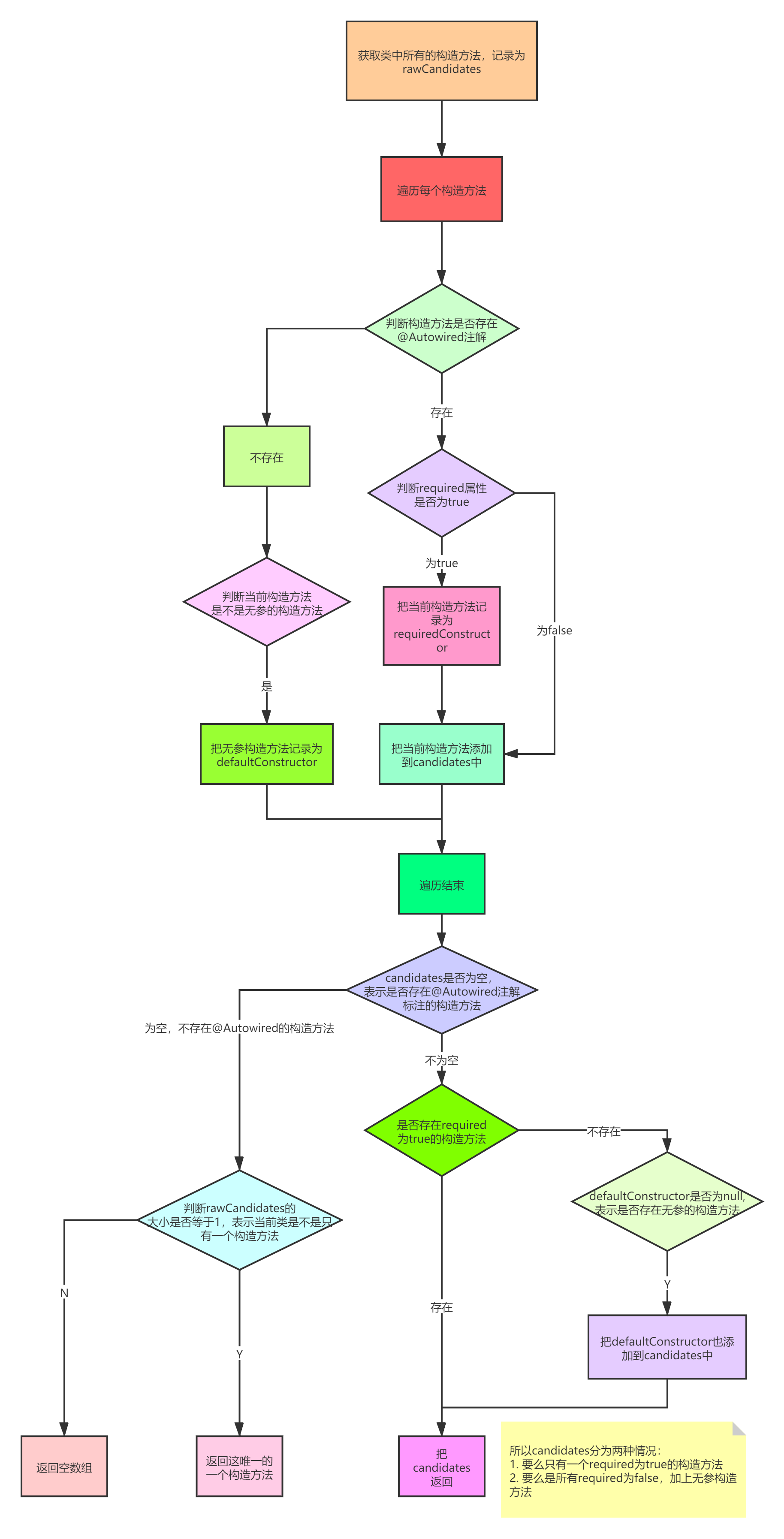Spring源码分析(八) Spring中推断构造方法源码解析
先补充一下@Configuration 注解的作用。
上节的源码分析中在bean工厂后置处理器 ConfigurationClassPostProcessor#postProcessBeanDefinitionRegistry 中解析配置类并开始扫描得到所有的 BeanDefinition 注册到容器里 。
开始扫描,是从"配置类"作为入口,一步一步把所有涉及到的bean扫描出来的。在Spring中判断是不是"配置类的"时候,并不是直接根据是否加了@Configuration 注解来的。

在 ConfigurationClassUtils.checkConfigurationClassCandidate(beanDef, this.metadataReaderFactory) 会判断是不是"配置类" ,然后添加到 configCandidates 集合中后面一块处理。
这个判断方法里里主要判断逻辑:

看到如果真正加了@Configuration的配置类,它的BeanDefinition中一个属性为 beanDef.setAttribute(CONFIGURATION_CLASS_ATTRIBUTE, CONFIGURATION_CLASS_FULL); ,这个属性的作用就决定了加@Configuration和不加,对bean创建的影响。
@Configuration @ComponentScan(value = "com.my.ioc.pojo.vo") //@Import({ Myregister.class,MyImport.class}) public class BeanConfig { @Bean public People people1() { Bird bird =bird(); return new People("people1"); } @Bean public Bird bird(){ Bird bird = new Bird(); bird.setName("bad bird"); return bird; } }
@Component public class AppConfig { @Bean public People people1() { Bird bird =bird(); return new People("people1"); } @Bean public Bird bird(){ Bird bird = new Bird(); bird.setName("bad bird"); return bird; } }
上面两种方式people1,和bird两个bean都能实例化创建。但是是有区别的。加了@Configuration的配置类,在类中进行方法相互调用的时候,会走代理的逻辑。因为加了@Configuration 的bd 中beanDef.setAttribute(CONFIGURATION_CLASS_ATTRIBUTE, CONFIGURATION_CLASS_FULL); 属性为full, 在ConfigurationClassPostProcessor#postProcessBeanFactory 中进行处理的时候,会根据属性为full, 覆盖beanDefinition中的beanClass属性,重新设置成一个代理类,这样其实在spring中使用BeanConfig,其实是代理类在处理。而不加@Configuration,就不是代理类来处理。
导致的结果就是。AppConfig中的在people1()方法中调用bird() ,得到会是一个新的对象,而不是单例的,因为它不会从spring容器中拿。而在BeanConfig中呢,在people1()方法中调用bird() ,得到的一直都是同一个对象,因为在Bird实例创建完之后会放到spring容器,其他地方调用bird()的时候,不会再新创建而是从容器中获取。在代理类中这部分逻辑是通过判断当前调用的方法名people1和被调用的方法名bird是不是同一个,如果不是同一个,则它尝试用方法bird从spring容器中获取一个实例返回出来。
增强类以及逻辑在 ConfigurationClassEnhancer#BeanMethodInterceptor# intercept 中。
private static class BeanMethodInterceptor implements MethodInterceptor, ConditionalCallback { /** * Enhance a {@link Bean @Bean} method to check the supplied BeanFactory for the * existence of this bean object. * @throws Throwable as a catch-all for any exception that may be thrown when invoking the * super implementation of the proxied method i.e., the actual {@code @Bean} method */ @Override @Nullable public Object intercept(Object enhancedConfigInstance, Method beanMethod, Object[] beanMethodArgs, MethodProxy cglibMethodProxy) throws Throwable { // 得到bean工厂和当前正在调用的beanMethod对应的beanName ConfigurableBeanFactory beanFactory = getBeanFactory(enhancedConfigInstance); String beanName = BeanAnnotationHelper.determineBeanNameFor(beanMethod); // Determine whether this bean is a scoped-proxy if (BeanAnnotationHelper.isScopedProxy(beanMethod)) { String scopedBeanName = ScopedProxyCreator.getTargetBeanName(beanName); if (beanFactory.isCurrentlyInCreation(scopedBeanName)) { beanName = scopedBeanName; } } // To handle the case of an inter-bean method reference, we must explicitly check the // container for already cached instances. // First, check to see if the requested bean is a FactoryBean. If so, create a subclass // proxy that intercepts calls to getObject() and returns any cached bean instance. // This ensures that the semantics of calling a FactoryBean from within @Bean methods // is the same as that of referring to a FactoryBean within XML. See SPR-6602. // 如果beanFactroy中存在beanName 并且也存在&+beanName所对应的bean 那么这个bean就是一个FactoryBean if (factoryContainsBean(beanFactory, BeanFactory.FACTORY_BEAN_PREFIX + beanName) && factoryContainsBean(beanFactory, beanName)) { Object factoryBean = beanFactory.getBean(BeanFactory.FACTORY_BEAN_PREFIX + beanName); if (factoryBean instanceof ScopedProxyFactoryBean) { // Scoped proxy factory beans are a special case and should not be further proxied } else { // 如果是FactoryBean 就对他进行代理 从缓存中得到getObject()的值 // It is a candidate FactoryBean - go ahead with enhancement return enhanceFactoryBean(factoryBean, beanMethod.getReturnType(), beanFactory, beanName); } } // 比如当前正在实例化的方法是userService()方法 所对应的bean,而userService()方法中调用user()方法 // 这个时候下面的这个判断等于false 就不会真正的去执行user()方法 会直接去beanFactory中去获取bean if (isCurrentlyInvokedFactoryMethod(beanMethod)) { // The factory is calling the bean method in order to instantiate and register the bean // (i.e. via a getBean() call) -> invoke the super implementation of the method to actually // create the bean instance. if (logger.isInfoEnabled() && BeanFactoryPostProcessor.class.isAssignableFrom(beanMethod.getReturnType())) { logger.info(String.format("@Bean method %s.%s is non-static and returns an object " + "assignable to Spring's BeanFactoryPostProcessor interface. This will " + "result in a failure to process annotations such as @Autowired, " + "@Resource and @PostConstruct within the method's declaring " + "@Configuration class. Add the 'static' modifier to this method to avoid " + "these container lifecycle issues; see @Bean javadoc for complete details.", beanMethod.getDeclaringClass().getSimpleName(), beanMethod.getName())); } // 走的是本身的逻辑 return cglibMethodProxy.invokeSuper(enhancedConfigInstance, beanMethodArgs); } // 这里是真正代理逻辑 return resolveBeanReference(beanMethod, beanMethodArgs, beanFactory, beanName); }
分析
Spring中的一个bean,需要实例化得到一个对象,而实例化就需要用到构造方法。
一般情况下,一个类只有一个构造方法:
- 要么是无参的构造方法
- 要么是有参的构造方法
如果只有一个无参的构造方法,那么实例化就只能使用这个构造方法了。
如果只有一个有参的构造方法,那么实例化时能使用这个构造方法吗?要分情况讨论:
- 使用AnnotationConfigApplicationContext,会使用这个构造方法进行实例化,那么Spring会根据构造方法的参数信息去寻找bean,然后传给构造方法
- 使用ClassPathXmlApplicationContext,表示使用XML的方式来使用bean,要么在XML中指定构造方法的参数值(手动指定),要么配置autowire=constructor让Spring自动去寻找bean做为构造方法参数值。
上面是只有一个构造方法的情况,那么如果有多个构造方法呢?
又分为两种情况,多个构造方法中存不存在无参的构造方法。
分析:一个类存在多个构造方法,那么Spring进行实例化之前,该如何去确定到底用哪个构造方法呢?
- 如果开发者指定了想要使用的构造方法,那么就用这个构造方法
- 如果开发者没有指定想要使用的构造方法,则看开发者有没有让Spring自动去选择构造方法
- 如果开发者也没有让Spring自动去选择构造方法,则Spring利用无参构造方法,如果没有无参构造方法,则报错
针对第一点,开发者可以通过什么方式来指定使用哪个构造方法呢?
- xml中的<constructor-arg>标签,这个标签表示构造方法参数,所以可以根据这个确定想要使用的构造方法的参数个数,从而确定想要使用的构造方法
- 通过@Autowired注解,@Autowired注解可以写在构造方法上,所以哪个构造方法上写了@Autowired注解,表示开发者想使用哪个构造方法,当然,它和第一个方式的不同点是,通过xml的方式,我们直接指定了构造方法的参数值,而通过@Autowired注解的方式,需要Spring通过byType+byName的方式去找到符合条件的bean作为构造方法的参数值
再来看第二点,如果开发者没有指定想要使用的构造方法,则看开发者有没有让Spring自动去选择构造方法,对于这一点,只能用在ClassPathXmlApplicationContext,因为通过AnnotationConfigApplicationContext没有办法去指定某个bean可以自动去选择构造方法,而通过ClassPathXmlApplicationContext可以在xml中指定某个bean的autowire为constructor,虽然这个属性表示通过构造方法自动注入,所以需要自动的去选择一个构造方法进行自动注入,因为是构造方法,所以顺便是进行实例化。
当然,还有一种情况,就是多个构造方法上写了@Autowired注解,那么此时Spring会报错。
但是,因为@Autowired还有一个属性required,默认为ture,所以一个类中,只有能一个构造方法标注了@Autowired或@Autowired(required=true),有多个会报错。但是可以有多个@Autowired(required=false),这种情况下,需要Spring从这些构造方法中去自动选择一个构造方法。
创建过程源码思路
- AbstractAutowireCapableBeanFactory类中的createBeanInstance()方法会去创建一个Bean实例
- 根据BeanDefinition加载类得到Class对象
- 如果BeanDefinition绑定了一个Supplier,那就调用Supplier的get方法得到一个对象并直接返回
- 如果BeanDefinition中存在factoryMethodName,那么就调用该工厂方法得到一个bean对象并返回
- 如果BeanDefinition已经自动构造过了,那就调用autowireConstructor()自动构造一个对象
- 调用SmartInstantiationAwareBeanPostProcessor的determineCandidateConstructors()方法得到哪些构造方法是可以用的
- 如果存在可用得构造方法,或者当前BeanDefinition的autowired是AUTOWIRE_CONSTRUCTOR,或者BeanDefinition中指定了构造方法参数值,或者创建Bean的时候指定了构造方法参数值,那么就调用autowireConstructor()方法自动构造一个对象
- 最后,如果不是上述情况,就根据无参的构造方法实例化一个对象
autowireConstructor()
- 先检查是否指定了具体的构造方法和构造方法参数值,或者在BeanDefinition中缓存了具体的构造方法或构造方法参数值,如果存在那么则直接使用该构造方法进行实例化
- 如果没有确定的构造方法或构造方法参数值,那么
- 如果没有确定的构造方法,那么则找出类中所有的构造方法
- 如果只有一个无参的构造方法,那么直接使用无参的构造方法进行实例化
- 如果有多个可用的构造方法或者当前Bean需要自动通过构造方法注入
- 根据所指定的构造方法参数值,确定所需要的最少的构造方法参数值的个数
- 对所有的构造方法进行排序,参数个数多的在前面
- 遍历每个构造方法
- 如果不是调用getBean方法时所指定的构造方法参数值,那么则根据构造方法参数类型找值
- 如果时调用getBean方法时所指定的构造方法参数值,就直接利用这些值
- 如果根据当前构造方法找到了对应的构造方法参数值,那么这个构造方法就是可用的,但是不一定这个构造方法就是最佳的,所以这里会涉及到是否有多个构造方法匹配了同样的值,这个时候就会用值和构造方法类型进行匹配程度的打分,找到一个最匹配的
determineCandidateConstructors()方法执行流程:

为什么分越少优先级越高?
主要是计算找到的bean和构造方法参数类型匹配程度有多高。
假设bean的类型为A,A的父类是B,B的父类是C,同时A实现了接口D
如果构造方法的参数类型为A,那么完全匹配,得分为0
如果构造方法的参数类型为B,那么得分为2
如果构造方法的参数类型为C,那么得分为4
如果构造方法的参数类型为D,那么得分为1
可以直接使用如下代码进行测试:
Object[] objects = new Object[]{new A()}; // 0 System.out.println(MethodInvoker.getTypeDifferenceWeight(new Class[]{A.class}, objects)); // 2 System.out.println(MethodInvoker.getTypeDifferenceWeight(new Class[]{B.class}, objects)); // 4 System.out.println(MethodInvoker.getTypeDifferenceWeight(new Class[]{C.class}, objects)); // 1 System.out.println(MethodInvoker.getTypeDifferenceWeight(new Class[]{D.class}, objects));
所以,我们可以发现,越匹配分数越低。
构造函数选择的流程图解:






【推荐】国内首个AI IDE,深度理解中文开发场景,立即下载体验Trae
【推荐】编程新体验,更懂你的AI,立即体验豆包MarsCode编程助手
【推荐】抖音旗下AI助手豆包,你的智能百科全书,全免费不限次数
【推荐】轻量又高性能的 SSH 工具 IShell:AI 加持,快人一步
· go语言实现终端里的倒计时
· 如何编写易于单元测试的代码
· 10年+ .NET Coder 心语,封装的思维:从隐藏、稳定开始理解其本质意义
· .NET Core 中如何实现缓存的预热?
· 从 HTTP 原因短语缺失研究 HTTP/2 和 HTTP/3 的设计差异
· 分享一个免费、快速、无限量使用的满血 DeepSeek R1 模型,支持深度思考和联网搜索!
· 使用C#创建一个MCP客户端
· 基于 Docker 搭建 FRP 内网穿透开源项目(很简单哒)
· ollama系列1:轻松3步本地部署deepseek,普通电脑可用
· 按钮权限的设计及实现